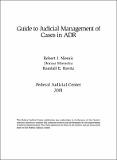| dc.coverage.spatial |
Estados Unidos |
| dc.date.accessioned |
2016-01-07T15:21:45Z |
| dc.date.available |
2016-01-07T15:21:45Z |
| dc.identifier.uri |
http://desa1.cejamericas.org:8080/handle/2015/813 |
| dc.description.abstract |
This publication offers guidance to federal trial and bankruptcy courts on when and how to refer appropriate cases to ADR and how to manage cases referred to ADR. FJC research found that although much has been written about basic ADR concepts, little comprehensive, easily accessible advice on ADR referrals had been written from the court’s perspective. The purpose of the book is not to advocate ADR use but rather to present various approaches that judges and parties may choose to follow when considering and using ADR. The book identifies areas where there may be disagreement, describing advantages and disadvantages of various approaches. The book also alerts readers to emerging trends or what are perceived by many as preferred approaches. The publication’s ten chapters have titles including Considering the Use of ADR: How and When Selecting Cases Appropriate for ADR and Matching the ADR Process to the Case. Other topics covered are neutral selection and compensation party consent client attendance party participation confidentiality Referral orders and case management issues. |
| dc.title |
Guide to Judicial Management of Cases in ADR |
| dc.ceja.source |
Fuente: <a href="http://www.fjc.gov/ag">Federal Judicial Center</a>, 2001, 193 p. |

